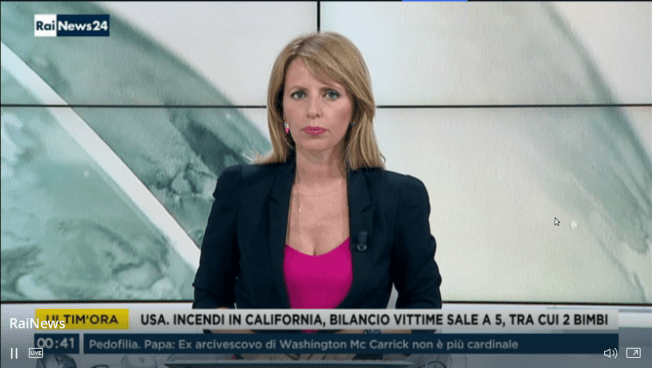Journalists covering demonstrations against COVID-19 countermeasures have been called “terrorists,” “pedophiles,” “murderers,” and “scumbags.” Protesters have harassed and assaulted members of the press, and told them that “the nooses are ready.”
Threats like these have become increasingly familiar for reporters in Europe and the United States, where the U.S. Press Freedom Tracker, a CPJ partner, has recorded threats and assaults against reporters in cities including Los Angeles and Portland, Oregon.
Journalists in Europe told CPJ that some protesters target members of the press, who they see as representing the same forces they are rallying against. While most of the reporters vowed to continue their coverage of demonstrations against lockdowns, masks, and COVID vaccines, some also voiced concern that reporters—especially those without institutional support, like freelancers—may not be able to continue much longer.

A new quality of anger
For Antonella Alba, a reporter with Italian public broadcaster Rai News 24, an August encounter with a violent group of protesters in Rome was a watershed moment.
“In my 20 years of reporting, I have covered student movements and workers’ protests but never have I been confronted with such an immediate violence to the very simple questions I asked about who [demonstrators] are and why they are protesting,” she told CPJ via phone.
When Alba asked a group of people why they had gathered to protest the government’s vaccine mandate, they responded by calling her a “terrorist journalist,” a term often used by extreme-right groups, and a woman shoved her while attempting to grab her cellphone, bruising her arm, as seen in video Alba posted to Twitter. (Alba said that police have identified the alleged attacker and a criminal investigation is underway.)
Protesters believe that journalists — especially those working for public broadcasters — represent “the government’s propaganda” on anti-COVID-19 measures, Alba said, adding that she thought that was why they vented their anger about public health measures at members of the press.
Similarly, in August 2020, Anne Höhn, a reporter for German state broadcaster Deutsche Welle, found herself amid a hostile crowd at an anti-lockdown protest in Berlin.
“People just suddenly became very physical, they were trying to touch me, push me, it was scary,” she told CPJ in a video call. “It was a new quality of anger: I was targeted not because I did something, but simply because I was a journalist.”

Höhn told CPJ that the protesters resented the media’s perceived role as gatekeepers allegedly controlling information, and also did not want to be the subject of critical coverage. She said some of the protesters took out their phones and filmed her as she was filming them.
“It was to show that if you cover us, we will cover the way you cover us,” she said.
Demonstrators have even broken into news organizations, as happened in Slovenia in September 2021.
“They shouted complaints about our coverage and wanted to occupy our studios and broadcast their views,” Manica Janežič Ambrožič, editor-in-chief of information programming at the public broadcaster RTVS, told CPJ via phone. She said protesters may feel that journalists are not doing their jobs properly, because they do not see their anti-vaccine views reflected in media. She added that the demonstrators had a generalized anti-establishment anger, which was then directed at the media.
“Journalists have become scapegoats for everything people are not satisfied with during this crisis,” she said.
A long-term trend accelerated by the pandemic
Martin Hoffmann, vice-chair of the Leipzig-based European Institute for Journalism and Communication Research, a research institute, told CPJ in a phone interview that such anti-journalist anger is connected to political changes in Europe following the refugee and migration crisis in 2015.
Hoffmann co-authored a March 2020 study on anti-press actions in Germany, which noted that terms like “lying press” (Lügenpresse) and violence against journalists have “become a dangerous normal in everyday journalistic work since 2015” and “the public hatred of the press is now part of the ideological inventory among right-wing and radical [movements].”
Hoffmann said that the pandemic has accelerated this trend.
“Journalists can expect attacks anytime, anywhere, even when they record a simple vox-pop in a Christmas market,” he said, noting that the Querdenker protest movement—German for “lateral thinkers”—initially began as a mix of people with different ideologies united by their opposition to the government’s pandemic policies, but had since become predominantly a right-wing movement.
Anti-lockdown and anti-vaccine protesters “want to control the narrative about their movement and journalists who highlight their connections to the extreme right, neo-Nazi groups are simply uncomfortable,” Austrian freelance journalist Michael Bonvalot told CPJ via phone.

Demonstrators at a September anti-vaccine rally in Vienna harassed Bonvalot, shouting that they knew where he lived. One of them threw a beer can at him, Bonvalot said. He added that that attack “was nothing special, not even the worst,” and that he had already been harassed several times, and also received death threats.
Bonvalot said many of the Vienna protesters knew him from his previous coverage, where he highlighted demonstrators’ connections to the extreme right. “They hate to be named, and what they hate most are pictures, revealing personal ties to neo-Nazi groups. Reporters taking photos and videos are in special danger,” he said.
“This is becoming unbearable”
Ambrožič, who interacted several times with protesters who gathered at RTVS’ headquarters leading up to their attack on the office, said she did not see how members of the press could cater to the demonstrators’ demands without sacrificing their journalistic integrity.
“How can I give airtime to people who deny the virus and whose views go against basic scientific facts?” she asked.

Hoffman agreed, telling CPJ that “journalists should not give voice to those who deny the virus or the efficiency of the vaccine or who go against basic facts, but they would have to continue to cover opinions critical of the handling of the pandemic.”
Reporters in Europe told CPJ that authorities were slow to act on the threats, and that police protective measures were often insufficient. Ambrožič said that RTVS had informed police several times about protesters’ harassment of journalists outside the headquarters, but authorities did not intervene.
Bonvalot told CPJ that the Vienna police had announced plans to have dedicated officers at demonstrations to respond to threats against journalists, but he was skeptical that journalists would be able to find those specific officers at the moment of need.
CPJ emailed the police in Ljubljana and Vienna for comment but did not receive any responses.
“Journalists must be way more careful than ever before I can remember,” Bonvalot said. He told CPJ that he would continue covering demonstrations, but now was always accompanied by four to six people who volunteer to help him if necessary.
He added that he always wears a helmet, padded protective vest, and goggles while covering protests where he may be physically harassed, and also has a special case for his camera. While those measures allow him to report more safely, they are expensive, especially for freelancers who are purchasing those goods with their own money.
Bonvalot says he’s willing to pay for additional equipment to keep covering the protests, but “it can come to a point where it is not possible to report on these events, because it is simply not safe enough,” he told CPJ.
Even with institutional support, covering such demonstrations can prove difficult. Höhn told CPJ that going to protests with bodyguards adds its own complications, because journalists cannot mingle freely with crowds and talk to people as easily.
Hoffmann added, “If these threats remain on the current scale, more and more journalists, especially freelancers, will think twice before they would expose themselves to physical danger, or risk their equipment.”
“Being a journalist has always meant a certain level of risk,” Ambrožič said, “but the level of anxiety and stress due to the threats have increased enormously and it is becoming unbearable. It is a very harsh world for journalists, right now.”
